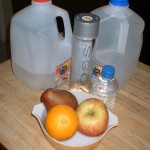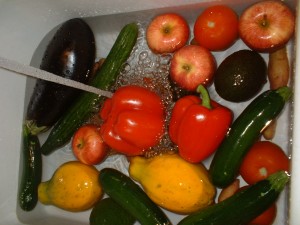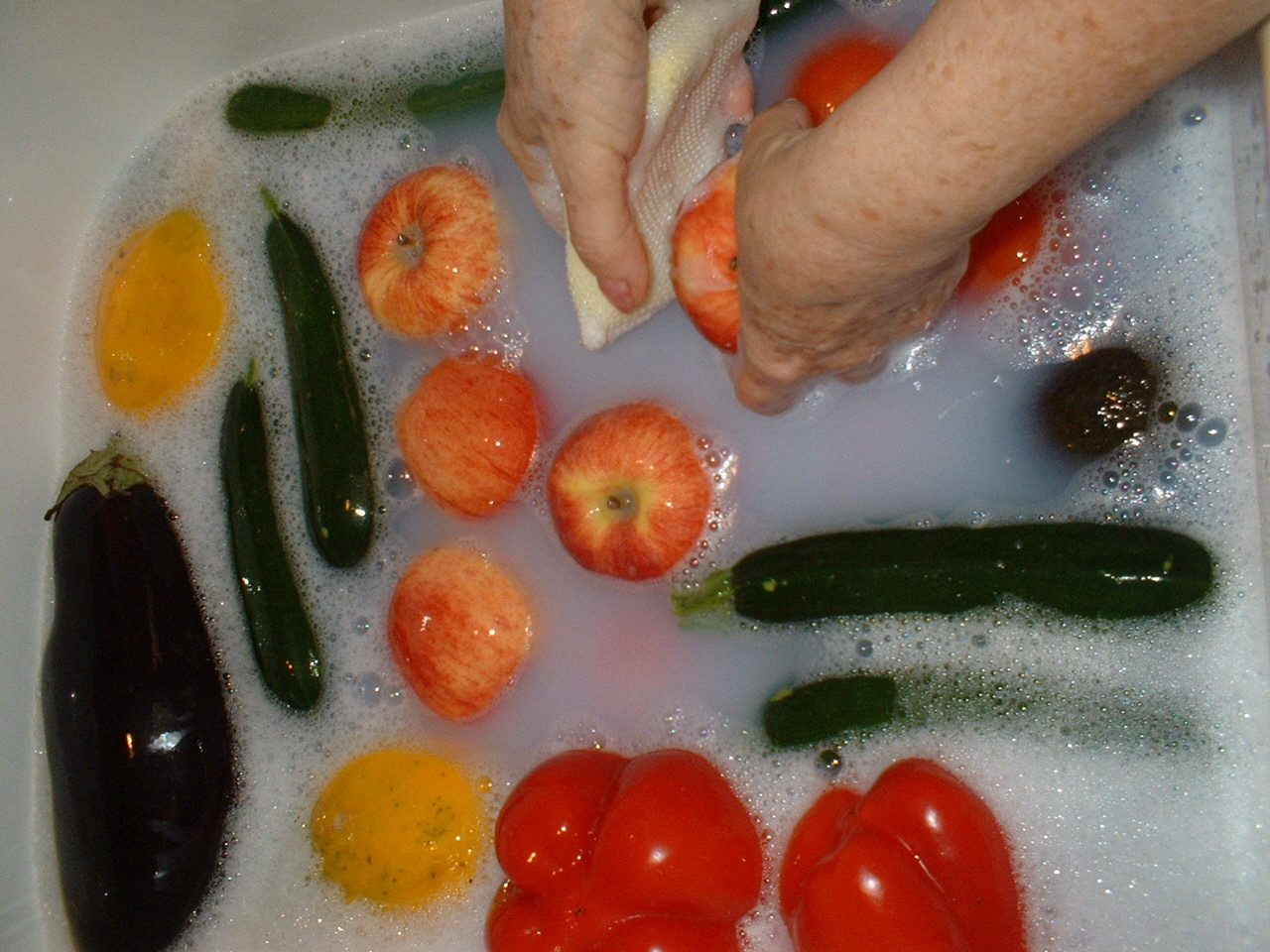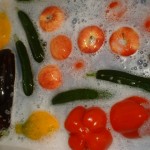By Dina Eliash Robinson
I PUBLISHED THIS ARTICLE AWHILE AGO. DUE TO THE PANDEMIC AND OUR NEED TO BE CAREFUL WHILE HANDLING OUR FOOD I THOUGHT IT WOULD BE HELPFUL FOR THESE TIMES!
Water—clean, uncontaminated and fit to drink—is the world’s most precious, and increasingly scarce commodity. As the planet heats up and its population grows, we’re in danger of running out of this resource, upon which depends the survival of our entire ecosystem. To prevent us from sliding into a bleak “Mad Max” world, we must become super-smart in water use, management and conservation.
With the following Smart Water Management Practices Tips, the Free Range Club is kicking off a friendly competition of ideas and practices that could help improve the ways we treat, recycle and purify H2O in our households, industries and public utilities. Top three winners of this competition will be rewarded with copies of our own Kitchen Shrink’s (a.k.a. Catharine Kaufman) latest (and delightfully illustrated), children’s book, featured on this site: “Joleen – The Adventures of a Junkfood Queen.”
• Buy Only Produce You Plan to Use Soon:
(1) Fruits and vegetables depend on, and consist mostly of water. The faster they get from farm to stove, oven or fridge, the more of their nutritional value, flavors and textures will be available for our consumption.
(2) Plan your meals around the fresh produce you buy that day.
(3) Buy only what, and as much as you have time to clean, cook, prepare or store within the next 24-36 hours.
(4) Shop for fresh produce just before your frozen foods and perishable fresh meats, fish and other seafood. And don’t leave these in the car while you run other errands.
(5) Do NOT store fresh-from-the-store eggs before you wash them.
• Water-Miser Produce Cleaning:
(1) At home, put the bags of leafy vegetables in the fridge temporarily, so they won’t wilt while you wash the rest of the produce.
(2) Put any berries you bought on the top shelf of your fridge. Berries are the only produce that should not be pre-washed. When you want some, take out only the amounts you plan to eat right away; dunk them into a small bowl of water with a squirt of liquid Eucalyptus Pure Castile soap; gently swish them around with your fingers; pour it all into a small colander or sieve and rinse well under the faucet with a moderate spray (if you have the sprinkle setting on your faucet) of cold water. Berries are now ready to eat—on their own, or in cereals, yogurt, etc.
(3) For grapes and cherry tomatoes, fill the appropriate size bowl with cold water; add a generous squirt of liquid Eucalyptus Pure Castile soap; add grapes and cherry tomatoes; wash gently with your hands; transfer to another bowl with clean cold water and rinse well; repeat this, then put grapes and cherry tomatoes into a colander and rinse well again under cold water, using the sprinkle setting. Next, stand the colander on a rack or plate where the water can drain and let the produce drip and dry till morning. Dry remaining water by dabbing gently with dish- or paper towel; transfer grapes into one bowl, tomatoes into another and refrigerate, so you can just reach for a handful when you want it. They keep well for a week or more.
(4) Put all your fruits and non-leafy veggies that have skin (but NOT the berries, grapes or cherry tomatoes) into a clean sink. Fill it with enough cold water to cover them; turn off the faucet; add ¼ cup of liquid Eucalyptus Pure Castile soap; and using a clean sponge—preferably a Dobie pad—scrub separately each fruit and veggie, applying more pressure to those with tough skins (bananas, apples, oranges, avocadoes, potatoes, etc.) and less to delicate ones (tomatoes, zucchini, etc.).
Note: Be careful not to break their skins—but if you do, rinse those off right after scrubbing, dry with dish- or paper-towel, put them on a plate and store in the fridge, to be used before the rest.
 (5) Next, let the water out of the sink and rinse well both sink and produce with a cold spray from the faucet. (Castile soap rinses off very easily, leaving the produce squeaky clean, with no soapy residue.)
(5) Next, let the water out of the sink and rinse well both sink and produce with a cold spray from the faucet. (Castile soap rinses off very easily, leaving the produce squeaky clean, with no soapy residue.) 
Place the produce into an empty dish-rack or big colander to dry overnight. If it’s not completely dry by the morning, wipe with dish- or paper towel, store bananas in a paper-towel-lined basket or on a banana rack; leave unripe produce (avocadoes, oranges, etc.) in a colander or bowl, away from heat until ripe enough to be refrigerated; and store ready-to-eat fruit, tomatoes and salad veggies in your refrigerator’s produce drawer. This way they’ll keep for two or more weeks and are always ready to eat when you reach for them.
(6) Repeat the above process with the leafy veggies (lettuce, kale, chard, spinach, etc.), rinsing the leaves in small batches under the faucet if necessary. If you have a salad spinner, use it for your salad greens, then store them in clean plastic bags on the top (least cold) shelf of your refrigerator. Put leafy cooking veggies into a colander to let most of the water drip down—but make sure you cook them within an hour after they’re washed.
Advantages of above system are that it protects health and saves both water and time. It’s easy to check the following B & C. Health effects (A) take longer to show.
(A) Putting only clean produce into your refrigerator protects your and your family’s health from bacteria and, if any of the produce is not organic, from pesticide residues which can also transfer to other foods.
(B) It saves water. You may not realize it, but if you take an unwashed fruit out of the fridge, you’ll run more water to wash it than you would use on a batch of produce. Plus, people in a hurry do a poor job of washing whatever they grab out of the refrigerator on the fly.
(C) It takes much more time to wash individual produce items than taking care of this chore all at once.
A Point Worth Dwelling On: Far more valuable than diamonds and gold, H2O is the main component of living organisms—our bodies included—and thus the source of all nourishment and breathable air. More wars, economic stresses, political shenanigans and health crises have been triggered throughout history by the need to have, protect and control water than any other resource. Even wild animals that often go hungry to avoid danger, will brave it when thirsty by joining predators for a drink. The need for water is so well understood in the wild that predators and prey usually observe a truce while slacking their thirst at the same water hole.
Being smart about water also means to protect it from pollution and finding new technologies to remove agricultural, industrial and pharmaceutical toxins that continue to leach into our rivers, streams, oceans and groundwater. Any ideas?
Join the Smart Water Management Tips contest by e-mailing us your ideas at [email protected]



8 Comments on “Save Water, Health & Time – Smart Water Management Practices”
Hi Dina – thanks for your comments and link to your incredible blog! I have
a habit of washing all vegetables, including bananas, and encourage others
to do the same. Imagine all the dirt, germs, chemicals and grimy hands that
have touched fresh produce? Yuck!
I do question the safety of using clorox on edible food. I cant see how
that can be good for you or the environment.
I would to hear your comments and as well as others in this group on this.
Tonya M Peele, MS
Check out my food blog! – The Lunch Junkie
http://www.thelunchjunkie.com
Hi Tonya,
So sorry it took this long to answer your concern about adding Clorox to water in which we wash NON-ORGANIC produce.
We started to do this more than 30 years ago in New York City, where organic produce was scarce at the time & we were concerned that the cold-water-liquid-Castile-soap-wash did not remove enough (never mind all) of the pesticides, fungicides, etc. that stuck to the skins of fruits & veggies.
So I went on a long quest for solutions & my multi-months research & the advice of several holistic health practitioners who came highly recommended—and who had also done extensive research on this issue—resulted in first my rejecting the idea of adding Clorox to water when washing produce, then doing more research to allay my doubts, & finally becoming convinced that it won’t harm us or the environment.
(My research did, however, alert me to the danger of drinking & cooking with water treated with Fluoride—which is, alas, the case in many cities & was almost unavoidable. I had to accept in the end that 100% safety is an unattainable ideal.)
Because of the tiny quantity of Clorox used (less than full CAPFUL of the small Clorox container’s cap in a kitchen sink full of clean, cold water) and also being reassured by a couple chemists whom I interviewed at the time, that it had a rather simple & relatively harmless formula, I became eventually convinced that soaking un-peeled, SKIN-ON produce (with the exception of berries) for 15-20 minutes (20 minutes usually for thick-skinned melons only) & then quickly rinsing them off, then washing with Castile soap & rinsing well again, is completely safe, as well as effective in removing the really toxic pesticides. Of course, I was still obsessing about the waste water going down my drain—an unpleasant environmental tradeoff.
Hope this reassures you.
We wish you good health & silver linings…
Dina
Is Hemp Peppermint Pure Castile Soap acceptable to use on fresh produce?
Yes! But I have found the Eucalyptus-Castile to be the most effective.
Hi Dina,
Thanks for the invitation to subscribe to the Free Range Club, but the truth is that I don’t cook. I know that seems strange to someone who loves all things food, but I just quit cooking after my life got super busy and something had to go.
I appreciate organic everything and lots of vegetarian dishes and our solution is to have a personal chef prepare these things and deliver them to our house.
I just wanted you to know why I didn’t subscribe. I have the greatest respect for your writing and your commitment to healthy eating.
I hope our paths will cross again in the not to distant future.
Cheers,
Elizabeth
Elizabeth Hansen
http://www.ElizabethHansen.net
Travel Writer/Photographer
2565 Ardath Rd.
La Jolla, CA 92037
Tel. 858-459-8851
FAX 858-454-8868
Having new nutrition challenges, your informative FreeRangeClub is perfect for a review of practical delicious food choices and recipes. My challenge is to simplify my meals, easy prep, and routine.
Current SIMPLE breakfast routine:
Odd days….Day 1…. 2 eggs–fried in coconut oil, and gluten free toast with butter.
Even Days….Day 2….cooked oatmeal with goat yogurt and fresh berries.
Important: Gluten free, no whey products….not even ice cream.
Dr. Luan Linquist
Wow! These are amazing and very helpful tips. Thank you so much Dina. I’ve learned a lot. I want to be smart about water and protect it from pollution so I will surely do these.
Having gone to the trouble of this research only to accept poisoned water! Dina do the same as Benjamin Franklin take the tap water and DISTIL it. There are cheap stills that produce 4 litres enough to cook and drink. When thin protein filters using the property of 4th PHASE water are developed it will be even easier.